Optimization of High Pressure/Temperature Assisted Synthesis of Cyclo(His-Pro)
2016-11-14ZHANGYanrongFANHongxiuLIUTingtingLIUHongcheng
ZHANG Yanrong, FAN Hongxiu, LIU Tingting, LIU Hongcheng
(College of Food Science and Engineering, Jilin Agricultural University, Changchun 130118, China)
Optimization of High Pressure/Temperature Assisted Synthesis of Cyclo(His-Pro)
ZHANG Yanrong, FAN Hongxiu, LIU Tingting, LIU Hongcheng
(College of Food Science and Engineering, Jilin Agricultural University, Changchun 130118, China)
In this study the synthesis of cyclo(His-Pro) was investigated under high pressure/temperature condition. Using dipeptide methyl ester hydrochloride as starting material, cyclo(His-Pro) was synthesized in water by high pressure/ temperature assisted cyclization. Influences of different reaction variables including pressure, time, solution pH and substrate concentration on the yield of cyclo(His-Pro) were investigated by single-factor experiments, and then an orthogonal array design was used to optimize the cyclization conditions. Quantification and identification of cyclo(His-Pro) in the product were carried out by ultra performance liquid chromatography (UPLC) and electro spray ionization mass spectrometry(ESI-MS). The optimum cyclization conditions were determined as follows: reaction pressure, 0.20 MPa; reaction time,3.5 h; solution pH, 6.0; and substrate concentration, 15 mg/mL. Under such conditions, cyclo(His-Pro) was obtained in excellent yield (91.35%) and no racemization was observed in the reaction process. In contrast to the classic methanol-reflux cyclization, this method is rapid, environmentally friendly and highly efficient.
cyclo(His-Pro); high pressure/temperature technology; cyclization; cyclic dipeptides preparation
ZHANG Yanrong, FAN Hongxiu, LIU Tingting, et al. Optimization of high pressure/temperature assisted synthesis of Cyclo(His-Pro)[J]. Food Science, 2016, 37(8): 18-25. DOI:10.7506/spkx1002-6630-201608004. http://www.spkx.net.cn
张艳荣, 樊红秀, 刘婷婷, 等. 环(组氨酸-脯氨酸)二肽的高温高压辅助合成工艺优化[J]. 食品科学, 2016, 37(8): 18-25. DOI:10.7506/spkx1002-6630-201608004. http://www.spkx.net.cn
Cyclic dipeptides are peculiar heterocyclic compounds derived from the cross-link between two amino acid residues via a pair of complementary amide bonds[1]. These peptides are found to exist in human, animals, plants, bacteria and fungus[2], showing a multitude of interesting biological activities such as antimicrobial[3], antitumoral and antiviral[4],cytotoxic[5], and neuroprotective effects[6]. The structural rigidity of the cyclic dipeptides increases their stabilitytowards proteolysis, making their half-lives in vivo much longer than those of linear peptides[7]. All these properties make cyclic dipeptides an interesting group of compound for the development of new functional foods and therapeutic agents.
Among such dipeptides, cyclo(His-Pro) or histidylproline diketopiperazine (CHP) is an endogenous cyclic dipeptide produced by primary cleavage of amino-terminal pyroglutamic acid from thyrotropin releasing hormone by pyroglutamyl aminopeptidase[8]. It is present in mammalian gut, blood and central nervous systems[9]. CHP has been reported to attenuate ethanol-induced hypothermia and anesthesia[10], prevent the neuronal death induced by free radicals and traumatic injury[11-12], suppress food intake and regulate blood glucose levels[13-14]. All these properties suggest that CHP may be useful in the treatment of obesity and diabetes, alcohol addiction and in vivo neuronal degeneration.
CHP is mainly synthesized by methanol-reflux method based on head-to-tail cyclization of linear dipeptide methyl ester in methanol under thermal condition[15]. However,the yield of this method is generally low. It requires long reaction time, causes epimerization to varying extents and costs lots of chemical reagents, leading to environmental problems. In recent years several new approaches, such as microwave assisted heating, have been developed to enable efficient head-to-tail cyclization for the synthesis of diketopiperazine[16]. High pressure/temperature technology has been proven to be highly successful in increasing reaction yields and reducing reaction time. Thajudeen et al.[17]reported cyclization of the tert-butyloxycarbonyl-protected dipeptide under high pressure/temperature conditions in a short period of time. Idris et al.[18]also reported a rapid and efficient synthesis for nickel sulfide powder using high pressure/temperature technology. However, to the best of our knowledge, the use of high pressure/temperature technology for the synthesis of CHP has not been investigated much. In order to develop a rapid, high efficient, environmentally benign synthetic procedure for CHP with low unfavorable racemization,we applied high pressure/temperature technology to cyclization of dipeptide methyl ester hydrochloride in water for the synthesis of CHP. In order to get high yield of CHP, a single-factor test and an orthogonal experiment (L9(34)) were applied to optimize the cyclization conditions. Quantification and identification of the cyclic dipeptide by ultra performance liquid chromatography(UPLC) and electro spray ionization mass spectrometry (ESIMS) were also conducted. Since there haven't been many reports in the literature on the synthesis of CHP using high pressure/ temperature technique, our research work may provide a new method for the efficient synthesis of CHP.
1 Materials and Methods
1.1Materials and reagents
The standard CHP (98%) was purchased from GL Biochemistry Incorporated (Shanghai, China). HPLC-grade water (H2O) and acetonitrile (ACN) were purchased from Merck Corporation (Darmstadt, Germany). Trifluoroacetic acid (TFA, 99%) was purchased from Sigma Aldrich Corporation (Shanghai, China). Silica gel 200-300 mesh and pre-coated silica gel G plates were purchased from Qingdao Ocean Chemicals (Qingdao, China), respectively. L-Proline, L-histidine, dicyclohexylcarbodiimide (DCC),1-hydroxybenzotriazole (HOBt), di-tert-butyldicarbonate((Boc)2O), triethylamine (Et3N), dichloromethane(CH2Cl2), chloroform (CH3Cl3), methanol (CH3OH),tetrahydrofuran (THF) and ethyl acetate (EtOAc) were of analytical grade or better.
1.2Instruments and equipments
High pressure/temperature reactor (YXQ-SG41-280-A,Shanghai Shenhua Incorporated); magnetic stirring apparatus(IT-09A-5, Shanghai Yiheng Scientific Instrument Company);pH meter (PHS-3BW, Shanghai Lida Instrumental Plant);ultra performance liquid chromatographic system (ACQUITY H-Class, Waters Corporation, USA); electro spray ionization mass spectrometer (MicroOTOF-QⅡ, Bruker Daltonics Corporation,Germany); vacuum drying oven (DZF-6050, Shanghai Jinghong Instrument Company Limited); rotary evaporator (RE-52AA,Yarong Biochemistry Instrumental Plant).
1.3Methods
1.3.1Preparation of L-histidine-proline-methyl ester hydrochloride
L-Histidine-proline-methyl ester hydrochloride was synthesized according to the method described by Ma Yaping et al.[19]with some modifications, and the synthetic procedure is outlined in Fig.1. The reactions were monitored by thin-layer chromatography (TLC) in solvent systems: CH3Cl3/CH3OH/ H2O (65∶25:4, V/V), detecting spots by iodine vapor or 1% ninhydrin in acetone after hydrochloric acid hydrolysis.
1.3.1.1Synthesis of Nim-tert-butoxycarbony-Nα-tertbutoxycarbony-L-histidine (Nim-Boc-Nα-Boc-L-His,Compound 2)
L-Histidine (Compound 1, 0.1 mol) was suspended in a mixture of 100 mL of THF and 100 mL of H2O, and thesolution was adjusted to pH 8.0-9.0 with 2 mol/L K2CO3.(Boc)2O (0.2-0.25 mmol) was added to the mixture at 0 ℃and the reaction was stirred at the same temperature for 1 h,then allowed to warm up to room temperature and stirred for 24 h. TLC analysis showed a major component of Nim-Boc-Nα-Boc-L-His (Rf0.68) and almost complete disappearance of L-histidine (Rf0.00). After removal of solvent in vacuum the residue obtained was re-dissolved in water and washed with diethyl ether (15 mL) twice. The aqueous solution was brought to pH 3.0-5.0 with aqueous citric acid and the precipitated white solid was extracted by EtOAc (30 mL) for four times. The combined extract was washed with saturated NaCl, dried over Na2SO4and concentrated in vacuum to obtain a yellowish amorphous solid (yield: 75%-85% ).
1.3.1.2Synthesis of L-proline-methyl ester hydrochloride(L-Pro-OMe·HCl, Compound 4)
L-Proline (Compound 3, 0.1 mol) was dissolved into dry methanol. Hydrogen chloride gas generated from the reaction of sulfuric acid and sodium chloride was bubbled into the solution and the reaction was stirred in an ice-bath for 3-5 h. TLC analysis showed a major component of L-Pro-OMe·HCl(Rf0.61) and almost complete disappearance of L-proline (Rf0.12). After evaporation of the solvent in vacuo, the residue was dissolved and re-evaporated from methanol thrice to remove HCl completely. The pure Compound 4 was obtained as a yellowish oil (yield: 92%-97%).
1.3.1.3Synthesis of Nim-tert-butoxycarbony-Nα-tertbutoxycarbony-L-histidine-L-proline-methyl ester (Nim-Boc-Nα-Boc-L-His-L-Pro-OMe, Compound 6)
A mixture of Compound 2 (10 mmol) and HOBt (12-20 mmol) were dissolved in 250 mL of dry CH2Cl2. The mixture was cooled to 0 ℃ and then DCC (15-20 mmol) was added to the reaction mixture. Compound 4 (10-20 mmol) was neutralized with Et3N and added into the reaction mixture. The reaction was allowed to warm up to room temperature and stirred overnight. The N,N’-dicyclohexylurea was filtered off and the filtrate was concentrated in vacuum. The residue was dissolved in EtOAc, filtered and concentrated in vacuum again. This step was repeated for three times. The obtained residue was redissolved in EtOAc, washed successively with saturated NaCl, saturated NaHCO3and saturated NaCl again,dried over Na2SO4, and concentrated in vacuum. The crude product was purified by silica gel column chromatography using petroleum ether/EtOAc (8:2, V/V) as eluent to obtain the pure Compound 6 (yield: 85%-95%). The final product showed one spot by TLC (Rf0.85).
1.3.1.4Synthesis of L-histidine-proline-methyl ester hydrochloride ( L-His-Pro-OMe·2HCl, Compound 7)
Compound 6 (8 mmol) was dissolved in 50 mL of EtOAc. Hydrogen chloride gas generated from the reaction of sulfuric acid and sodium chloride was bubbled into the solution and the reaction was stirred in an ice-bath. After 4 h the solution was concentrated under vacuum to give the title product as an oily residue (yield 93.1%). The product gave a streaky spot according to TLC (Rf0.13).
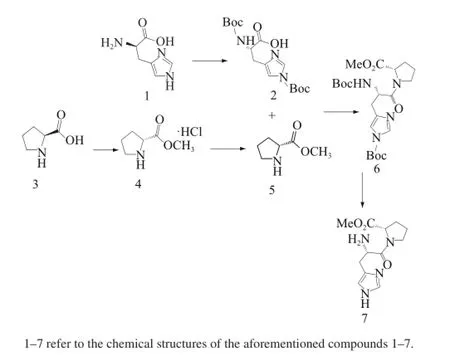
Fig.1 Synthesis of L-histidine-proline-methyl ester hydrochloride
1.3.2Preparation of CHP
1.3.2.1High pressure/temperature assisted cyclization
200 mg of L-histidine-proline-methyl ester hydrochloride(Compound 7, 0.59 mmol) was dissolved in water at a required substrate concentration, and the pH value of the solution was adjusted with NaHCO3. Then the solution was sealed and subjected to high pressure/temperature assisted cyclization. After reaction, the solution was filtered through quantitative filter paper and the filtrate was evaporated in vacuum to give the product as yellowish solid. The product was weighed. Sample solution was prepared by dissolving 20 mg of the product in 100 mL of 2% acetonitrile and 0.05% TFA in deionized water. Then the sample solution was filtered through a 0.22 μm membrane filter and analyzed by UPLC.
1.3.2.2Methanol-reflux method
Cyclization of the dipeptide methyl ester hydrochloride was carried out in refluxing methanol according to the method described by Tan Xiancan et al.[20]. Briefly, 200 mg of L-histidine-proline-methyl ester hydrochloride (Compound 7, 0.59 mmol) was dissolved in 8.5 mL of methanol, and the pH was brought to 7.0-8.0 with NaHCO3. The solution wasrefluxed for 20 h. After reaction the solution was filtered through quantitative filter paper and evaporated in vacuum to give the product as yellowish solid. The product was weighed. Sample solution was prepared by dissolving 20 mg of the product in 100 mL of 2% acetonitrile and 0.05% TFA in deionized water. Then the sample solution was filtered through a 0.22 μm membrane filter and analysed by UPLC.
1.3.3Determination of yield of CHP
Quantitative analysis of CHP was carried out in a Waters ACQUITY H-Class UPLC system equipped with a DAD detector. Samples were separated on a ACQUITY UPLC H-Class HSS T3 column(100 mm × 2.1 mm, 1.7 µm) column at 35 ℃, using a gradient elution method (mobile phase A: water/trifluoroacetic acid, 100:0.05 (V/V) and mobile phase B: acetonitrile). The gradient elution conditions were 0-3 min,2%-80% B; 3-6 min, 80% B. Elution was done at a flow rate of 0.2 mL/min, and sample injection volume was 2 μL. The CHP was measured at 220 nm and quantified by the external standard. The content of CHP in the sample was calculated based on its peak area fitting on the calibration curve obtained from the standard CHP (y=973 115x+1 196.4, where x is the concentration of standard CHP and y is the area of peak). The yield of CHP was calculated as follows:

Where X is the yield of CHP/%; c is the concentration of CHP in the sample obtained by standard curve/(mg/mL); V is the volume of the sample/mL, m is the weight of the sample/ mg; M is the total weight of product/g; M0is theoretical weight of product when the yield is 100%/g.
1.3.4ESI-MS analysis
ESI-MS analysis of the cyclization product was performed using positive ionization mode on a Bruker microOTOF-QⅡmass spectrometer. Settings were as follows: desolvation temperature 380 ℃, ionization voltages 3 kV, cone voltage 10 V,ion source temperature 110 ℃, dry gas flow 600 L/h, cone gas flow 80 L/h, scan range m/z 50-450.
1.4Statistical analysis
All the experiments were performed in triplicate (n=3),and statistical analysis was performed using SPSS 16.0. Data were expressed asComparisons among groups were performed with one-way analysis of variance test (ANOVA)and Duncan's multiple-range test. The Fisher test value (F value) was obtained from the ANOVA test generated by the software. Differences were considered significant at P<0.05.
2 Results and Analysis
2.1Results of single-factor test
2.1.1Effect of reaction pressure on the yield of CHP
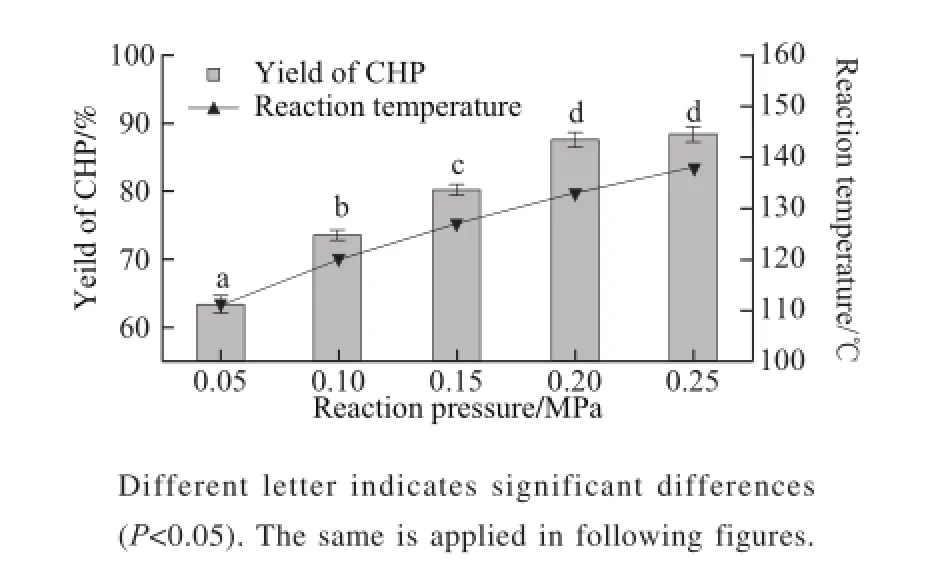
Fig.2 Effect of reaction pressure on the yield of CHP and reaction temperature
The yields of CHP affected by different reaction pressures were shown in Fig.2, when other three factors (reaction time, solution pH and substrate concentration) were fixed at 2.5 h, 7, and 15 mg/mL. In the range of 0.05-0.20 MPa,the yield of CHP increased drastically with increasing reaction pressure. Then it increased in a mild slope when the reaction pressure continued to increase. Besides, the reaction temperature increased remarkably as the reaction pressure increased, and the results showed that higher pressure and temperature are profitable for the good yield. Considering energy consumption and cost of production, reaction pressure of 0.15-0.25 MPa was adopted for further study objects in the orthogonal test.
2.1.2Effect of reaction times on the yield of CHP
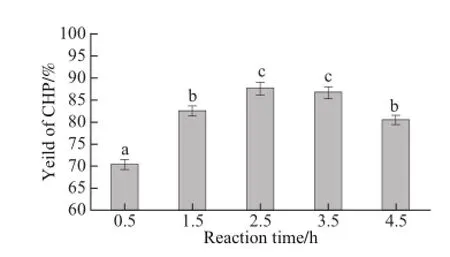
Fig.3 Effect of reaction time on the yield of CHP
The yields of CHP affected by different reaction times was shown in Fig.3, when other three factors (reaction pressure, solution pH and substrate concentration) were fixed at 0.2 MPa, 7, and 15 mg/mL. A noticeable increase was observed in the yield of CHP as the reaction time was increased from 0.5 to 2.5 h, and the CHP yield reached the maximum value at 2.5 h. Then the yield started to decreaseslowly when the reaction time exceeded 3.5 h. So in this study reaction time of 1.5-3.5 h was adopted for further study objects in the orthogonal test.
2.1.3Effect of solution pH on the yield of CHP
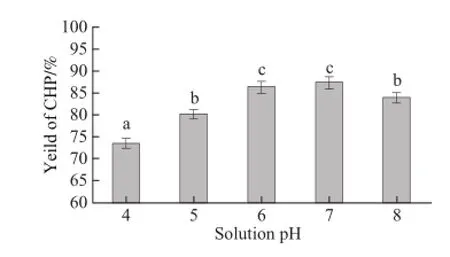
Fig.4 Effect of solution pH on the yield of CHP
As the dipeptide methyl ester was existed in the form of hydrochloride salts, it needs to be neutralized with right amount of base to freed the histidine amine for subsequent cyclization[21]. The yields of CHP affected by different solution pH values were shown in Fig.4, when other three factors (reaction pressure, reaction time and substrate concentration) were fixed at 0.2 MPa, 2.5 h, and 15 mg/mL. The yield of CHP was increased with increasing solution pH and plateaued at 7, after which, the yield of CHP started to decrease. So in this study solution pH of 6-8 was adopted for further study objects in the orthogonal test.
2.1.4Effect of substrate concentrations on the yield of CHP
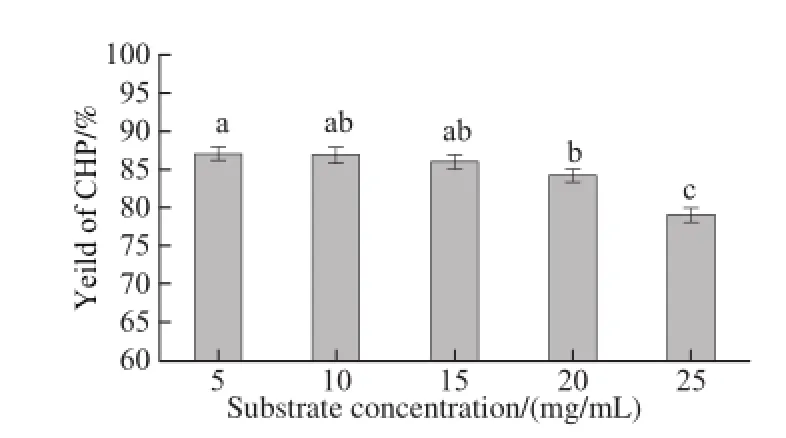
Fig.5 Effect of substrate concentration on the yield of CHP
The yields of CHP affected by substrate concentrations was shown in Fig.5, when other three factors (reaction pressure, reaction time and solution pH) were fixed at 0.2 MPa, 2.5 h, and 7. The yield of CHP decreased in a mild slop when the substrate concentration increased from 5 to 15 mg/mL, and the CHP yield decreased drastically when the substrate concentration was beyond 20 mg/mL. This suggests that lower substrate concentration is profitable for the cyclization reaction. However, in practical production, lower substrate concentration would lead to a low productivity. So in this study substrate concentration of 10-20 mg/mL was adopted for further study objects in the orthogonal test.
2.2Optimization of cyclization conditions with orthogonal test design
In the present study, a L9(34) orthogonal design, which made up of 9 test parameters, 4 factors and 3 levels, was used to optimize the reaction conditions of high pressure/ temperature assisted cyclization. Reaction pressure (A),reaction time (B), solution pH (C) and substrate concentration(D) were used as the processing factors and the range of each factor level was based on the above experiment results of the single-factor. The yield of CHP was employed as the evaluation indicator. The orthogonal design and experimental results were shown in Table 1.
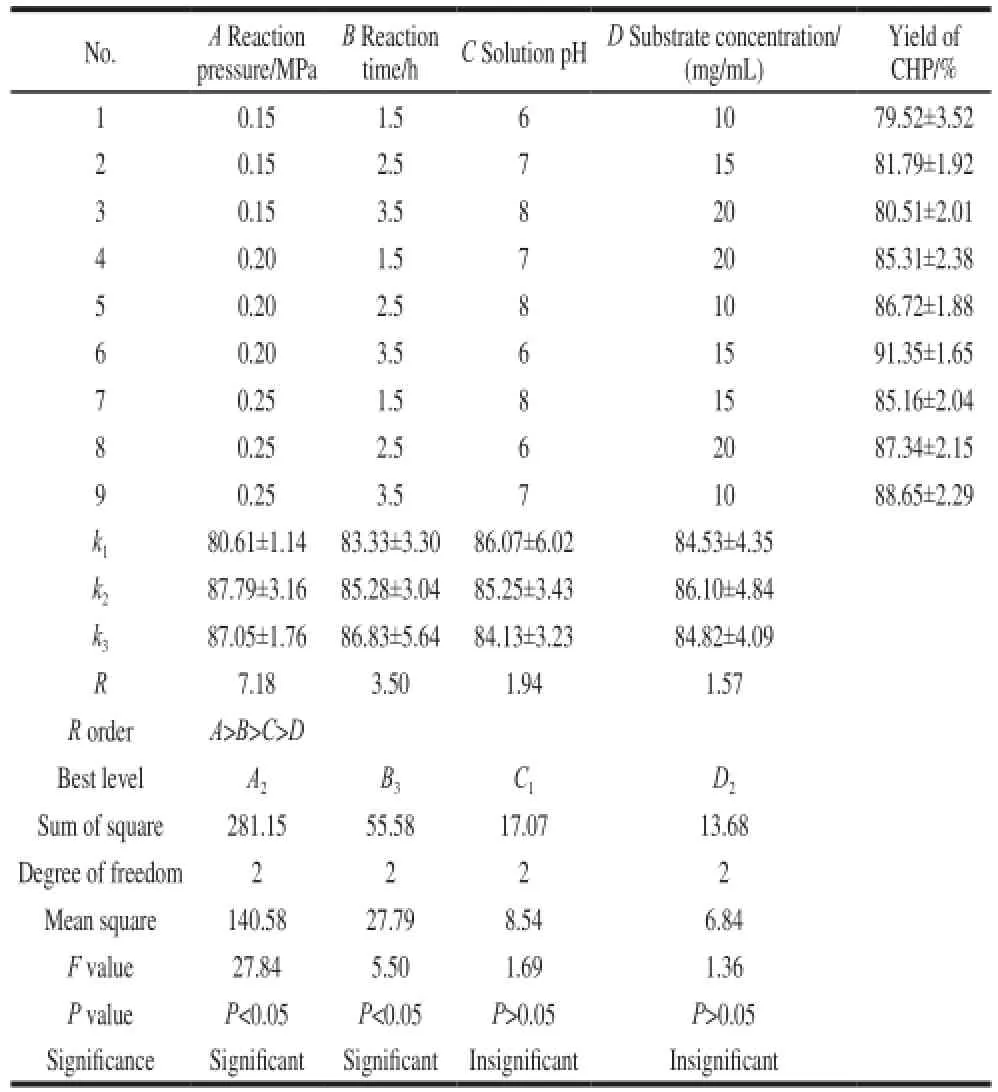
Table 1 Factors and levels used in orthogonal array design and experimental results for high pressure/temperature assisted cyclization
Results of the range analysis (Table 1) showed that the influential orders of the four factors to the yield of CHP were A>B>C>D. The Fisher's F test provided a decision at some confidence level as to whether these factors have significant effect on experimental indicators or not[22]. Accordingly, the larger F value means the greater significant effect the factor made. Results of ANOVA for the orthogonal experiment indicated that the most significant parameter (P<0.05) was found to be the reaction pressure, followed by reaction time, while solution pH and substrate concentration were insignificant (P>0.05) for the yield of CHP. This finding was in accordance with the results of R analysis. Based on the range and ANOVA analysis, the optimum reactioncondition for high pressure/temperature assisted cyclization was A2B3C1D2. The maximum yield of CHP reached to(91.35±1.65) % on the optimal reaction level.
2.3Comparison of different cyclization methods
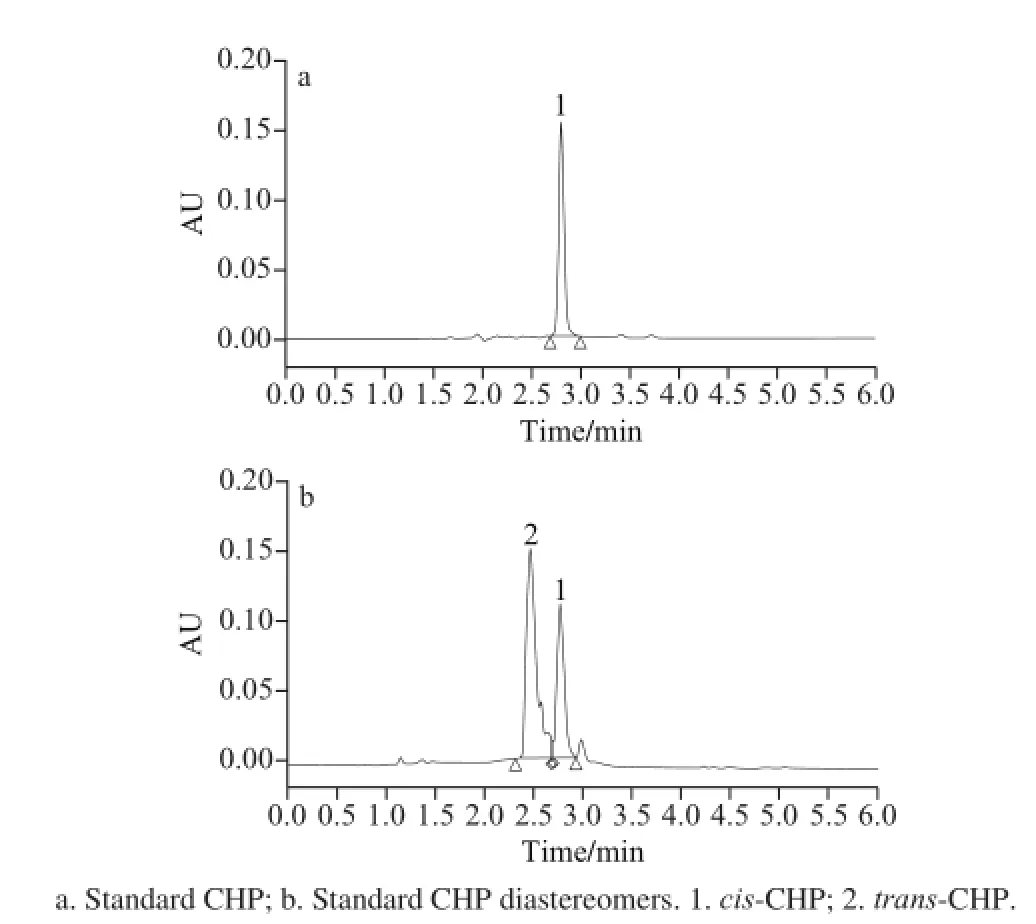
Fig.6 UPLC chromatograms of CHP and its diastereomers standards
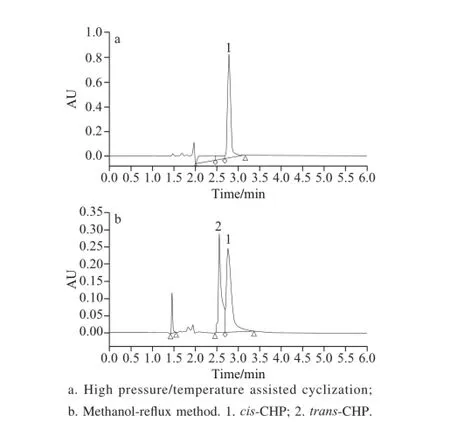
Fig.7 UPLC chromatograms of products obtained by high pressure/ temperature assisted cyclization and methanol-reflux method

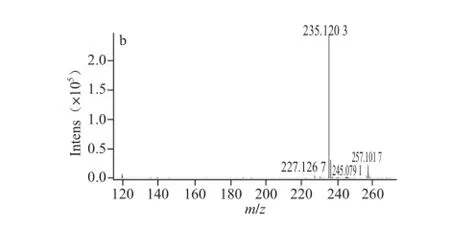
Fig.8 ESI-MS spectra of CHP at retention times of 2.574 min (a, peak 2)and 2.778 min (b, peak 1) as shown in Fig.7b
In order to compare with high pressure/temperatureassisted cyclization, the methanol-reflux method was also employed. During the methanol-reflux cyclization, the amounts of L-histidine-proline-methyl ester hydrochloride and UPLC analysis were kept as the same as that in high pressure/temperature assisted cyclization and the method was operated under the optimal condition reported by others. The chromatograms of UPLC for CHP are shown in Fig.6. The chromatograms of UPLC for the products obtained by methanol-reflux method and high pressure/temperatureassisted cyclization methods are shown in Fig.7. It can be seen that the chromatogram of the product obtained by methanol-reflux method showed two main peaks at retention times of 2.574 min and 2.778 min, and the area ratio of the two peaks was determined to be 1:2.24. By matching with the chromatogram of standard CHP (Fig.6a), peak 1 can be identified as CHP. In Fig.8 the corresponding mass spectra of peak 1 and peak 2 in the product of methanol-reflux method are given respectively. It can be seen that the MS of peak 1 is similar to the MS of the identified CHP of peak 2. The fragmentation pattern and fragment intensity of both ESIMS spectra were identical. Therefore it was concluded that both the cis and the trans forms of CHP were formed in the methanol-reflux method.
The standard CHP is optically pure compound and consists of only cis-CHP. For further analysis of optical purity of the product, we subjected the standard CHP to 3 equiv. of NaHCO3in refluxing methanol to allow isomerization[23]. Through UPLC and ESI-MS analysis, the standard showed two peaks (Fig.6b) with identical mass spectra. By comparison with the retention times it can be stated that under the UPLC conditions applied in this study, the trans cyclic dipeptide elutes before the cis cyclic dipeptide.
In Fig.7a the UPLC chromatogram of product obtained by high pressure/temperature assisted cyclization is shown. The chromatogram showed only one peak at the retention time of 2.782 min, suggesting that the product was opticallypure, and by comparison with the reference compound the peak was identified as CHP. This leads to the conclusion that only the cis form of CHP is formed during the HPHT assisted cyclization.

Table 2 Comparison of different cyclization methods
From Table 2 it can be seen that using methanolreflux method the yield of CHP was low, the reaction time was quite long, and partial racemization (30.86%) was observed during the reaction. However, using high pressure/ temperature-assisted cyclization, a much higher yield of CHP was obtained and the reaction time was reduced from 20 h to 3.5 h. High pressure has been reported to change intermolecular interaction and shorten intermolecular distance in the compounds, such effects help the linear dipeptide to overcome its own twist resistance, increase the chance of head-tail encounter and therefore contributes to the head-to-tail cyclization[24]. In addition, high pressure can improve the boiling point of solvent, resulting in an increase in the reaction temperature. A higher reaction temperature is profitable for the good yield or reducing the reaction time[25-26]. The results also suggested that the use of high pressure/temperature-assisted cyclization could induce no racemization. Compared to conventional solvents,water is preferred for the cyclization reactions because it is nontoxic, cheap and hazardless in handling. Therefore, the high pressure/temperature-assisted cyclization using water as solvent was environmentally benign and could be considered as a preferable route in the production of CHP.
3 Conclusion
In summary, we developed an alternative strategy for the synthesis of CHP by exploiting high pressure/temperature technology in the cyclization process of dipeptide methyl ester hydrochloride. The results showed that the optimum combination of parameters were as follows: reaction pressure,0.20 MPa; reaction time, 3.5 h; solution pH, 6.0; and substrate concentration, 15 mg/mL. CHP could be obtained with a yield of 91.35% in very short time, and no racemization was detected during the reaction. Comparing with the traditional methanol-reflux method, high pressure/temperature-assisted cyclization offers several advantages including higher yield,shorter reaction time and environmentally friendly conditions,making it a useful and attractive strategy in cyclic dipeptide production.
References:
[1] CAMPO V L, MARTINS M B, DASILVA C H T P, et al. Novel and facile solution-phase synthesis of 2,5-diketopiperazines and O-glycosylated analogs[J]. Tetrahedron, 2009, 65(27): 5343-5349. DOI:10.1016/j.tet.2009.04.069.
[2] CHEN Y H, LIOU S E, CHEN C C. Two-step mass spectrometric approach for the identification of diketopiperazines in chicken essence[J]. European Food Research and Technology, 2004, 218(6): 589-597. DOI:10.1007/s00217-004-0901-x.
[3] HOUSTON D R, SYNSTAD B, EIJSINK V G H, et al. Structurebased exploration of cyclic dipeptide chitinase inhibitors[J]. Journal of Medicinal Chemistry, 2004, 47(23): 5713-5720. DOI:10.1021/ jm049940a.
[4] MARRINS M B, CARVALHO I. Diketopiperazines: biological activity and synthesis[J]. Tetrahedron, 2007, 63(2): 9923-9932. DOI:10.1016/j.tet.2007.04.105.
[5] GRAZ C J M, GRANT G D, BRAUNS S C, et al. Cyclic dipeptides in the induction of maturation for cancer therapy[J]. Journal of Pharmacy and Pharmacology, 2000, 52(1): 75-82. DOI:10.1211/0022357001773535.
[6] PRAKASH K R C, TANG Y, KOZIKOWSKI A P, et al. Synthesis and biological activity of novel neuroprotective diketopiperazines[J]. Bioorganic and Medicinal Chemistry, 2002, 10(9): 3043-3048. DOI:10.1016/S0968-0896(02)00132-3.
[7] LEMUEL P P, JAIME E, HORACIO F O, et al. Efficient microwave assisted syntheses of 2,5-diketopiperazines in aqueous media[J]. Molecules, 2009, 14(8): 2836-2849. DOI:10.3390/ molecules14082836.
[8] KOO B K, SUH H J, RA K S, et al. Protective effect of cyclo(His-Pro) on streptozotocin-induced cytotoxicity and apoptosis in vitro[J]. Journal of Microbiology and Biotechnology, 2011, 21(2): 218-227. DOI:10.4014/jmb.1012.12003.
[9] MINELLI A, BELLEZZA I, GROTTELLI S, et al. Focus on cyclo(His-Pro): history and perspectives as antioxidant peptide[J]. Amino Acids,2008, 35(2): 283-289. DOI:10.1007/s00726-007-0629-6.
[10] PRASAD C. Role of endogenous cyclo(His-Pro) in voluntary alcohol consumption by alcohol L-preferring C57BL mice[J]. Peptides, 2001,22(12): 2113-2117. DOI:10.1016/S0196-9781(01)00570-8.
[11] MINELLI A, GROTTELLI S, MIERLA A, et al. Cyclo(His-Pro)exerts anti-inflammatory effects by modulating NF-κB and Nrf2 signalling[J]. International Journal of Biochemistry and Cell Biology,2012, 44(3): 525-535. DOI:10.1016/j.biocel.2011.12.006.
[12] ANDAMUTHU A, PONMALAI K. Structural analysis and the effect of cyclo(His-Pro) dipeptide on neurotoxins: a dynamics and density functional theory study[J]. Journal of Molecular Modeling, 2010,16(2): 193-202. DOI:10.1007/s00894-009-0531-0.
[13] CHOI S A, YUN J W, PARK H S, et al. Hypoglycemic dipeptide cyclo(His-Pro) significantly altered plasma proteome in streptozocininduced diabetic rats and genetically-diabetic (ob/ob) mice[J]. Molecular Biology Reports, 2013, 40(2): 1753-1765. DOI:10.1007/ s11033-012-2229-0.
[14] RA K S, SUH J, CHOI J W. Hypoglycemic effects of cyclo(His-Pro) in streptozotocin-induced diabetic rats[J]. Biotechnology and Bioprocess Engineering, 2012, 17(1): 176-184. DOI:10.1007/s12257-011-0618-1.
[15] DINSMORW C J, BESHORE D C. Recent advances in the synthesis of diketopiperazines[J]. Tetrahedron, 2002, 58(17): 3297-3312. DOI:10.1016/S0040-4020(02)00239-9.
[16] MARCUS T, MORTEN G, KRISTINA L. Efficient synthesis of 2,5-diketopiperazines using microwave assisted heating[J]. Tetrahedron, 2006, 62(31): 7484-7491. DOI:10.1016/ j.tet.2006.05.010.
[17] THAJUDEEN H, PARK K, MOON S, et al. An efficient green synthesis of proline-based cyclic dipeptides under water-mediated catalyst-free conditions[J]. Tetrahedron Letters, 2010, 51(9): 1303-1305. DOI:10.1016/j.tetlet.2009.12.134.
[18] IDRIS N H, RAHMAN M M, CHOU S L, et al. Rapid synthesis of binary α-NiS-β-NiS by microwave autoclave for rechargeable lithium batteries[J]. Electrochimica Acta, 2011, 58(1): 456-462. DOI:10.1016/ j.electacta.2011.09.066.
[19] MA Yaping, BAI Wei, ZHONG Fei, et al. A new method for preparing cyclo(His-Pro): China, CN1951954A[P]. 2007-04-25.
[20] TAN Xiancan, YU Zhengpeng. Synthesis of cyclodipeptide cyclo(L-His-L-Pro)[J]. Journal of Hainan Normal University, 2008, 21(2): 173-176. DOI:10.3969/j.issn.1674-4942.2008.02.015.
[21] YU Yan. Studies on chiral cyclic dipeptide with proline: synthesis,antimicrobial, antineoplastic activity and asymmetric catalyst[D]. Qingdao: Qingdao University of Science and Technology, 2010. DOI:10.7666/d.y1740344.
[22] ZHOU Cunshan, HU Jiali, MA Haile, et al. Antioxidant peptides from corn gluten meal: orthogonal design evaluation[J]. Food Chemistry,2015, 187: 270-278. DOI:10.1016/j.foodchem.2015.04.092.
[23] KUKLA M J, BRESLIN H J, BOWDEN C R. Synthesis,characterization, and anorectic testing of the four stereoisomers of cyclo (histidylproline)[J]. Journal of Medicinal Chemistry, 1985,28(11): 1745-17477. DOI:10.1021/jm00149a035.
[24] MACHO N D, MEERSMAN F, MCMILLAN P F, et al. Pressureinduced amorphization and polyamorphism: inorganic and biochemical systems[J]. Progress in Materials Science, 2014, 61: 216-282. DOI:10.1016/j.pmatsci.2013.12.002.
[25] JAM F, TULLBERG M, LURHMAN K, et al. Microwave assisted synthesis of spiro-2,5-diketopiperazines[J]. Tetrahedron, 2007, 63(39): 9881-9889. DOI:10.1016/j.tet.2007.06.108.
[26] TANG Zilong, PAN Zhi, LUO Juan, et al. Synthesis of chiral catalyst of cyclo dipeptides under microwave irradiation[J]. Chinese Journal of Synthetic Chemistry, 2008, 16(5): 542-545. DOI:10.3969/ j.issn.1005-1511.2008.05.012.
环(组氨酸-脯氨酸)二肽的高温高压辅助合成工艺优化
张艳荣,樊红秀,刘婷婷,刘鸿铖
(吉林农业大学食品科学与工程学院,吉林 长春 130118)
将高温高压技术应用于环(组氨酸-脯氨酸)二肽(cyclo(His-Pro),CHP)的制备。以二肽甲酯盐酸盐为原料,采用高温高压辅助环化法在水中制备CHP,通过单因素试验考察了各种反应变量如压力、时间、溶液pH值以及底物质量浓度对CHP产率的影响,采用正交试验对高温高压辅助环化工艺条件进行优化。采用超高效液相色谱法和电喷雾质谱技术对产物中的CHP进行定量和定性分析。结果表明,最佳的反应条件为:反应压力0.20 MPa、反应时间3.5 h、溶液pH 6.0、底物质量浓度15 mg/mL。在此条件下可以得到较高产率(91.35%)的CHP,并且反应中没有观察到消旋。与传统的甲醇回流法相比,本研究的环化方法省时、高效、环保,并且能够得到较高的产率,同时产物没有发生消旋。
环(组氨酸-脯氨酸)二肽;高温高压技术;环化反应;环二肽制备
10.7506/spkx1002-6630-201608004
TS219
A
1002-6630(2016)08-0018-08
2015-11-29
“十二五”国家科技支撑计划项目(2013BAD16B08);国家高技术研究发展计划(863计划)项目(2011AA100805)
张艳荣(1965—),女,教授,博士,主要从事粮油植物蛋白工程及功能食品研究。E-mail:xcpyfzx@163.com
引文格式:
